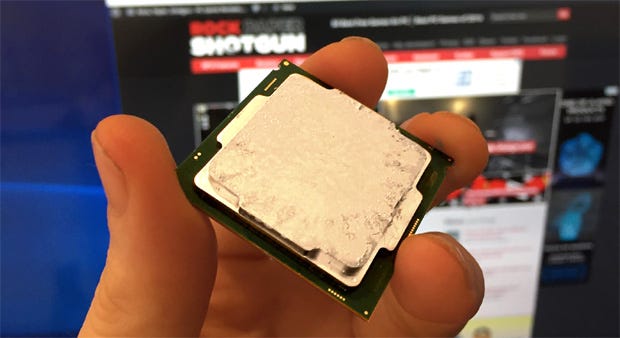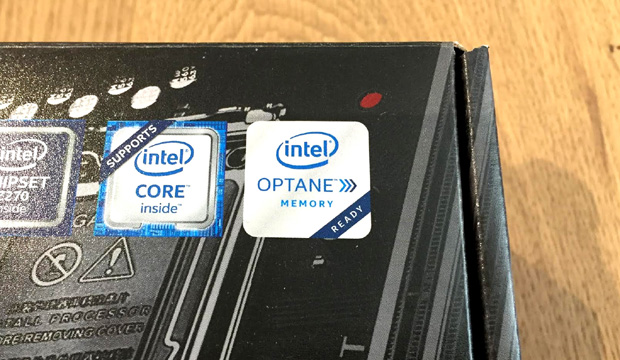Hands-On With Intel's New Kaby Lake CPU
Four cores and many years ago...
Behold. Intel has a new PC processor. Does it game, will it blend, is it AMD's Ryzen CPU you really want and what the hell happened to 'Tick Tock'? For answers to at least some of these questions, including the shattering news that the arrival of Kaby Lake means the era of 'Tick Tock' is over, summarily usurped by 'Process, Architecture, Optimisation' (or if leaked roadmaps are anything to go by, make that 'Process, Architecture, Optimisation and One More for the Road'), join me on the other side.
I'll save some of you a lot of trouble right from the get go and point out that Kaby Lake is fundamentally non-exciting, albeit for somewhat interesting reasons. It's another mainstream CPU family from Intel that tops out at four cores and only ups the performance ante by a small increment. Broadly speaking, we're talking less that 10 per cent performance improvement over existing Skylake CPUs from Intel.
Kaby Lake is, in short, probably the last boring mainstream chip from Intel before various factors align and force Intel out of its slumber and into something resembling action. More on that in a moment.
I've been hands-on with the two headline grabbing CPUs of the Kaby Lake range courtesy of MSI's Z270 Gaming M5 motherboard, which showcases the new 200 Series chipsets that accompany Kaby. The processors in question are the 4.2GHz/4.5GHz Core i7-7700K and the 3.8GHz/4.2GHz Core i5-7600K. Thus by their '7xxx' suffixes shall ye know Kaby Lake chips.
First, let's talk about what's new in Kaby Lake the CPU, which isn't much. The CPU cores are largely if not entirely identical to Skylake. The integrated graphics isn't new either, not in terms of 3D rendering at least. It's basically the same 'Gen9' integrated gunk as seen and not terribly enjoyed by gamers in Skylake chips.
So we're left with two really significant updates. The first involves manufacturing. Actually, Kaby Lake is a 14nm chip, which makes it the third such family from Intel. Hence the shift from the old so-called 'Tick Tock' paradigm which saw Intel crank out a new chip and a new production process in alternate years.
The significance here is that Intel has officially given up trying to shrink its CPU transistors every other year. That reflects a general industry-wide slow down in chip development as the world's silicon engineers increasingly bump up against the laws of physics.
Anyway, 'Tock tick' is toast and now we have aforementioned 'Process, Architecture, Optimisation', which buys Intel an extra year to get those tricky die shrinks out the door. Despite all that, Intel has refined the existing 14nm tech enough to bump Kaby Lake's clockspeeds by around 200MHz to 300MHz higher than previous chips depending on the model in question.
That's where the less-than-10-per-cent performance uptick figure comes from given that the CPU cores aren't any fancier. They just run a little quicker. That said, prior to launch the scuttlebutt implied that Kaby Lake might be quite the overclocker. Hold that thought.
The other potentially significant novelty involves 2D video. Yeah, not exactly gaming relevant. But for the record, Kaby Lake is potentially really snazzy in this department. Firstly, it has some major decode and encode chops. Thanks to some new 2D hardware, it can decode up to eight standard 4K HEVC streams simultaneously, which is kind of crazy, and can also support ultra-high bitrate streams, too, up to 4K at 60 frames per second and 120Mbps. It has some new encode capabilities, too.
Arguably even more newsworthy is some new DRM gubbins that will allow Kaby Lake PCs to be the first that are allowed to stream 4K Netflix content. Until now, that's been restricted to HDTV apps and set top boxes. However, what's not clear is whether that will only be possible when using the integrated graphics. Personally, I don't see how it makes sense unless it's tied to the integrated graphics, but we'll see.
But the point is that if you're looking for an all-round computing solution, Kaby Lake does have a few tricks up its sleeve. It won't make games run much faster. But if you're due an upgrade the 4K Netflix shizzle could be appealing and the hardware decode could also be interesting for laptops.
As for what the Core i7-7700K and the Core i5-7600K are like in the real world, I haven't much to say. To be frank, they feel no different to similar quad-core chips since, arguably, 2011 when Sandy Bridge arrived and shook things up. If you want benchmarks, try these.
 It's actually the platform and stuff like USB Type-C...
It's actually the platform and stuff like USB Type-C...
As you can see, it's a total wash versus any vaguely recent Intel CPU family in almost any game. The overclocking picture, however, is at least a little more interesting. I managed 5.2GHz from the Core i5-7600K and 5GHz from the Core i7-7700K. That's a few hundred MHz more than you might expect from a Skylake chip. Welcome, but to be brutally honest, again you just ain't gonna feel that kind of difference.
Arguably of more tangible import are the motherboards and chipsets. Kaby Lake sticks with the LGA1151 socket, so it slots into existing Intel 100 series motherboards. Praise the Lord for such small mercies.
That said, the new 200 Series chipsets do bring a few frills. Our muse for this purpose is MSI's new Z270 Gaming G5, which uses the top-end Z270 chipswet (obviously) in a sort of middling format in terms of pricing, which should weighing in at around £165 if the existing Z170 Gaming M5 is anything to go by.
There's support for DDR4-2400 RAM, for instance, and another four PCI Express 3.0 lanes on the chipset for peripherals, making for 24 in total. That said, the connection between the chipset and the CPU is the same DMI 3.0 thingamy, so the max bandwidth hasn't changed, which is about 4GB/s and thus a tiny fraction of the theoretical maximum of those 24 PCIE 3.0 lanes.
Additional intrigue comes in the form of an otherwise unassuming logo atop the Gaming G5's box. “Intel Optane Memory Ready”, it reads. But what does it mean? That's a story in itself (which I've touched on briefly, earlier), but the short version is that Intel has cooked up a new non-volatile memory tech. Like flash memory, it doesn't need power to maintain data storage. But it's far faster than flash memory. Think of it as being a cross between flash and RAM and you'll have the right rough idea.
How it will all work is a little unclear at this stage. It seems Optane will initially come in smallish drives of 16GB and 32GB and act as a sort of cache drive rather than as a conventional mass-storage hard drive. Eventually as the price comes down, I think we'll see straight-up Optane SSDs for mass storage.
Anyway, if you like the sound of Optane, support begins with the new 200 Series chipsets. Elsewhere, the MSI Gaming M5 serves ups various modern features, including a pair of M.2 slots and a USB Type-C port. So as has often been the case of late, it's actually the platform that looks more compelling as an upgrade option for a few-years-old PC, rather than the CPU.
The context to all this, of course, and the 'factor' I alluded to earlier is the imminent launch of AMD new's Ryzen CPU. Again, I'll cover the full story in another post, but Ryzen looks awfully promising and it's likely that Intel will be forced to respond with a major upgrade to its mainstream CPUs within the next year, including its first six-core mainstream chip.
 ...and generally bags of bandwidth with 200 Series motherboards like the MSI Z270 Gaming M5 that's arguably a bit interesting, not the Kaby lake chip itself...
...and generally bags of bandwidth with 200 Series motherboards like the MSI Z270 Gaming M5 that's arguably a bit interesting, not the Kaby lake chip itself...
All of which makes it pretty hard to get excited about Kaby Lake. In truth, you have to go back to Sandy Bridge in 2011 to find a mainstream Intel CPU that really moved the game forward. Kaby Lake doesn't change that. But hopefully it will be the last of its type, the last sand-bagging Intel chip, if you like. About bloody time it will be, too.
TL;DR
- By their 7xxx suffixes shall ye know Kaby Lake
- They change very little in terms of gaming performance
- They overclock pretty well
- It says something that 4K Netflix support is perhaps the main selling point
- The new 200 Series platform is probably more interesting than the CPU itself thanks to Optane memory support.



